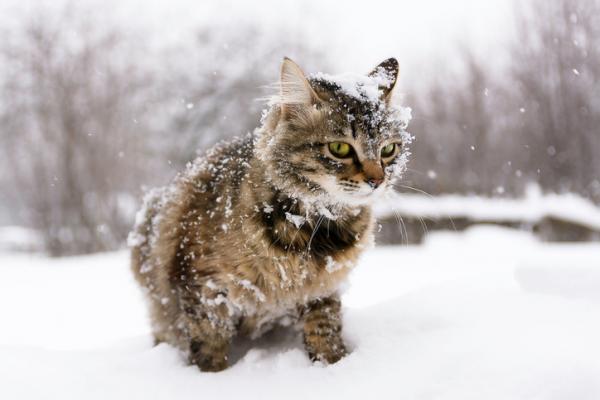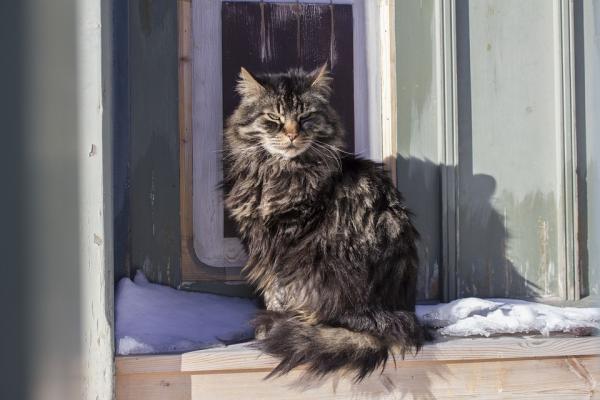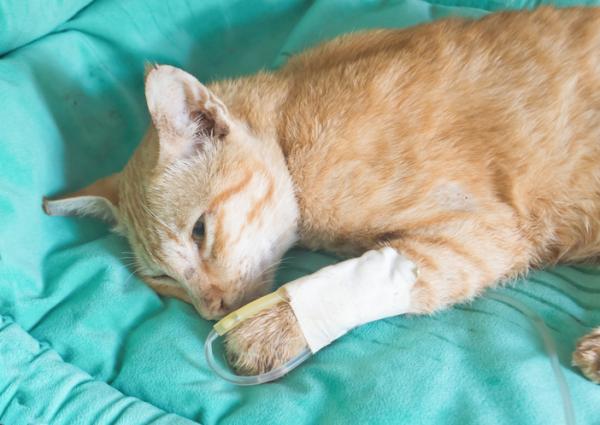Hypothermia in cats – Causes, symptoms and treatment

La hypothermia in cats it consists of a decrease in body temperature below normal values, which are around 38 and 39ºC. Symptoms show tremors, muscle rigidity and alteration of vital signs. Feline hypothermia is due to different causes and requires urgent treatment.
It is important to note that the arrival of winter brings with it the need to take care of our pets from the low temperatures and of the climatic changes. Exposure to cold, wind, rain and snow can severely threaten the health of our faithful companions.
On this occasion, invites you to know better hypothermia in cats, to know how to recognize their symptom and proceed correctly to offer your cat the treatment immediate that this table requires.
Feline hypothermia
La hypothermia it is considered a complex symptomatic picture caused by the decrease in body temperature. The ideal temperature for adult and healthy cats should be around 38 and 39ºC. [1] However, when the temperature drops below 36ºC, we will begin to observe tremors and other characteristic symptoms of hypothermia.
Causes of hypothermia in cats
In most domestic felines, the hypothermic picture appears after the exposure to cold and other severe weather conditions. However, some pathologies they can also hinder the natural regulation of body temperature in cats, as is often the case with hypothyroidism. In addition, alterations in the immune system they cause the animal to be much more vulnerable to suffer the symptoms of hypothermia.
The cats Babies They are especially vulnerable to a case of hypothermia, as they still can not regulate their body temperature by themselves, and their immune system is still forming. Therefore, it is essential to prevent our small cats from adverse conditions and from cambios climatic during the winter and go to the specialist urgently if our cat is a puppy cat.

Symptoms of hypothermia in cats
The Hypothermia symptoms in more frequent cats They are:
- Tremors
- Muscle stiffness
- Collapse
- Depression
- Lethargy
- Weakness
- Isolation
- Lack of energy
- Loss of appetite
- Stare and dilated pupils
- Disorientation
- Difficulty breathing
- Decrease in heart rate
- Decrease in respiratory rate
- Stupor
- Coma
Treatment of hypothermia in cats
It is essential to highlight that un hypothermia in cats requires immediate attention, especially if we talk about a puppy cat. The radical decrease in body temperature of an animal can cause sudden death or cause irreversible damage to health.
How to raise the temperature of a cat?
In the Pet Center Several steps can be taken to treat hypothermia in the cat:
- If the animal is wet, it will be dried with a towel.
- The cat will be moved to a slightly warm and controlled environment.
- It will proceed to perform an external heating.
- It may be necessary to use an enema or fluid therapy.
- The cat will be kept under observation until the veterinarian discharges.
Never rub the body of the animal, bathe in hot water or apply warm water directly, as well as use thermal blankets, as they can burn the feline’s skin, even when the minimum power is used.
With a low body temperature in cats, it is It is essential to go to the vet, since it is necessary to determine if there is any pathology that is causing the temperature drop or if this situation could have caused serious damage to the animal’s organism.
Still, in we are going to offer you some advice of first aid that you can follow if you find yourself in an emergency and the vet is at a considerable distance. The objective will be to try to avoid even further the drop in temperature and keep the cat alive:

First aid in the face of hypothermia in cats
1. Has your cat got wet?
Cats that are used to walking alone outside their home can get wet, either because of the snow, the humidity of the air or the rains. If you notice that your cat has got wet for any reason, do not hesitate dry it immediately. The humidity in your body, combined with low external temperatures, favors the appearance of hypothermia symptoms. You must use simply dry towels to dry it and provide heat to your body.
2. Provide warmth to the cat’s body
If we identify the decrease in body temperature in our cat before the onset of symptoms, or when these signs are still mild, we can choose to shelter our cat, wrapping it in a dry towel or put a pet coat on it.
We can also use our own body temperature to transmit heat. For example, load it wrapped in the towel in our arms. This generates a very positive sense of well-being and also helps keep our feline safe and quiet.
However, if our cat has already developed symptoms such as tremors, lack of appetite or lethargy, we must opt for a source of external heating. We can place the cat in a cardboard box or in a carrier and, next to it, bottles with warm water, never hot. Then you should go to the vet.
3. Balance glucose levels
The organism of the cat, as well as that of all mammals, adopts certain mechanisms to temporarily compensate for the decrease in body temperature and thus avoid drastic effects on the organism. To try to keep its internal temperature stable, the body starts to burn your energy reserves.
As a consequence, the animal suffers a rapid Hypoglycemia, that is, the lowering of sugar levels in your bloodstream. This can cause a severe lethargic state, which progressively leads to coma. To avoid this degenerative process and stabilize glucose levels quickly, we can offer 1 teaspoon miel to our cat.
4. Check your body to identify possible freezing injuries
If your cat has been exposed to very cold temperatures or suffered prolonged cold, it is likely that it will develop some wounds or burns characteristics of freezing. To identify them, you should check your entire body, paying special attention to the regions with the lowest hair concentration, such as ears, legs, tail and anus. If you find injuries or reddened areas, do not hesitate to tell your veterinarian.
5. Veterinary emergencies
Even if you have followed these steps and your cat shows a noticeable improvement, it will be essential to go to the veterinarian, to rule out that hypothermia has affected the health of your cat. However, in more serious cases, when the animal already presents loss of consciousness and even a comma, it will be essential to wrap the cat in a towel and go quickly to a veterinary center.
Faced with a serious case that puts the animal’s life at risk, more complex techniques should be used, such as the use of enemas, intravenous therapy, the use of electrolytes, fluid therapy and even oxygen therapy.

Is it possible to prevent hypothermia in cats?
Preventing hypothermia in cats and dogs is not only possible, it is also recommended and necessary. If we manage to maintain stable body temperature of our pets with the arrival of the coldest season of the year, we avoid unnecessary damage to their health.
- Measure body temperature daily in winter: This is a very efficient preventive measure in cats that have access to the outside, as it allows us to verify the decrease in body temperature before the onset of any hypothermia symptoms.
- Condition the home: With the arrival of winter, we must also prepare our home to provide warmth and well-being to our pets. The heating will be our best ally to maintain the ambient temperature between 24ºC and 26ºC.
- Essential accessories: It will also be fundamental to offer a nest or bed to our cat, with a blanket inside and we can even put a coat on our companion, in this way it will be warm and warm. These tips should be especially taken into account if we have a cat without hair.
This article is merely informative, in .com we do not have the faculty to prescribe veterinary treatments or make any kind of diagnosis. We invite you to take your pet to the veterinarian in case of any type of condition or discomfort.
If you want to read more articles similar to Hypothermia in cats – Causes, symptoms and treatment, we recommend that you enter in our section of Other health problems.


